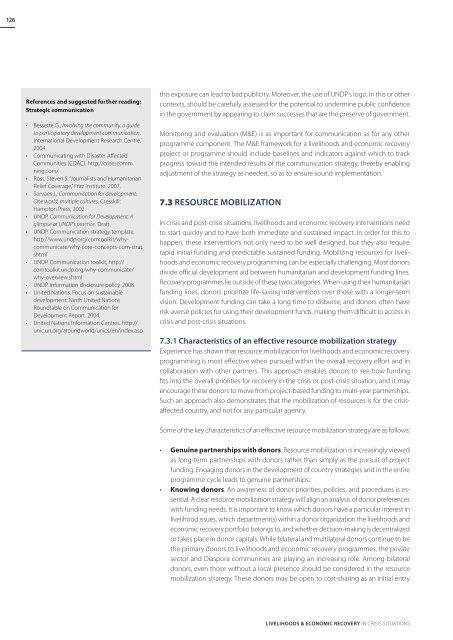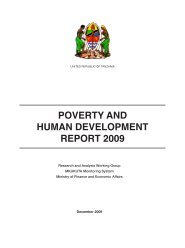Download PDF (4.08 MB) - ReliefWeb
Download PDF (4.08 MB) - ReliefWeb
Download PDF (4.08 MB) - ReliefWeb
Create successful ePaper yourself
Turn your PDF publications into a flip-book with our unique Google optimized e-Paper software.
126<br />
References and suggested further reading:<br />
Strategic communication<br />
• Bessette G., Involving the community, a guide<br />
to participatory development communication.<br />
International Development Research Centre,<br />
2004.<br />
• Communicating with Disaster Affected<br />
Communities (CDAC). http://crisescomm.<br />
ning.com/<br />
• Ross, Steven S. “Journalists and Humanitarian<br />
Relief Coverage,” Fritz Institute. 2007.<br />
• Servaes J., Communication for development:<br />
One world, multiple cultures. Cresskill:<br />
Hampton Press, 2002.<br />
• UNDP. Communication for Development: A<br />
glimpse at UNDP’s practice. Draft.<br />
• UNDP. Communication strategy template,<br />
http://www.undp.org/comtoolkit/whycommunicate/why-core-concepts-com-strat.<br />
shtml<br />
• UNDP. Communication toolkit, http://<br />
comtoolkit.undp.org/why-communicate/<br />
why-overview.shtml<br />
• UNDP. Information disclosure policy. 2008.<br />
• United Nations. Focus on sustainable<br />
development: Ninth United Nations<br />
Roundtable on Communication for<br />
Development Report. 2004.<br />
• United Nations Information Centres. http://<br />
unic.un.org/aroundworld/unics/en/index.asp<br />
this exposure can lead to bad publicity. Moreover, the use of UNDP’s logo, in this or other<br />
contexts, should be carefully assessed for the potential to undermine public confidence<br />
in the government by appearing to claim successes that are the preserve of government.<br />
Monitoring and evaluation (M&E) is as important for communication as for any other<br />
programme component. The M&E framework for a livelihoods and economic recovery<br />
project or programme should include baselines and indicators against which to track<br />
progress toward the intended results of the communication strategy, thereby enabling<br />
adjustment of the strategy as needed, so as to ensure sound implementation.<br />
7.3 Resource Mobilization<br />
In crisis and post-crisis situations, livelihoods and economic recovery interventions need<br />
to start quickly and to have both immediate and sustained impact. In order for this to<br />
happen, these interventions not only need to be well designed, but they also require<br />
rapid initial funding and predictable sustained funding. Mobilizing resources for livelihoods<br />
and economic recovery programming can be especially challenging. Most donors<br />
divide official development aid between humanitarian and development funding lines.<br />
Recovery programmes lie outside of these two categories. When using their humanitarian<br />
funding lines, donors prioritize life-saving interventions over those with a longer-term<br />
vision. Development funding can take a long time to disburse, and donors often have<br />
risk-averse policies for using their development funds, making them difficult to access in<br />
crisis and post-crisis situations.<br />
7.3.1 Characteristics of an effective resource mobilization strategy<br />
Experience has shown that resource mobilization for livelihoods and economic recovery<br />
programming is most effective when pursued within the overall recovery effort and in<br />
collaboration with other partners. This approach enables donors to see how funding<br />
fits into the overall priorities for recovery in the crisis or post-crisis situation, and it may<br />
encourage these donors to move from project-based funding to multi-year partnerships.<br />
Such an approach also demonstrates that the mobilization of resources is for the crisisaffected<br />
country, and not for any particular agency.<br />
Some of the key characteristics of an effective resource mobilization strategy are as follows:<br />
• Genuine partnerships with donors. Resource mobilization is increasingly viewed<br />
as long-term partnerships with donors rather than simply as the pursuit of project<br />
funding. Engaging donors in the development of country strategies and in the entire<br />
programme cycle leads to genuine partnerships.<br />
• Knowing donors. An awareness of donor priorities, policies, and procedures is essential.<br />
A clear resource mobilization strategy will align an analysis of donor preferences<br />
with funding needs. It is important to know which donors have a particular interest in<br />
livelihood issues, which department(s) within a donor organization the livelihoods and<br />
economic recovery portfolio belongs to, and whether decision-making is decentralized<br />
or takes place in donor capitals. While bilateral and multilateral donors continue to be<br />
the primary donors to livelihoods and economic recovery programmes, the private<br />
sector and Diaspora communities are playing an increasing role. Among bilateral<br />
donors, even those without a local presence should be considered in the resource<br />
mobilization strategy. These donors may be open to cost-sharing as an initial entry<br />
Livelihoods & Economic Recovery in Crisis Situations





